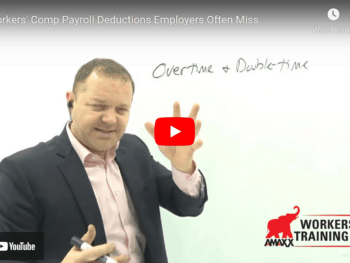Carriers have classes of adjusters usually correlating with each adjuster’s amount of experience. Although class names vary, they are usually divided into medical-only, lost time/Indemnity, litigation, and catastrophic adjusters.
1 – Medical-only adjusters
Medical-only adjusters, an entry level position, are trainees with little to no experience. They handle minor medical claims involving simple lacerations and minor strains/sprains not involving any lost wages or complicated medical injuries/conditions. When an employee has a few clinic visits the employer sends the claim in with the bills and the adjuster sets up the claim, processes the bills, and closes the claim.
Medical-only adjusters conduct the initial interview with the employer and the employee. The interview itself does not go into great detail or investigation as the injuries are usually minor with uncomplicated outcomes.
When claims are time limited (60 to 90 days) and the claimant continues to receive medical treatment, the claim may be transferred to the lost time adjuster. Look upon extended claims as a “red flag” indicating a possible reason the employee is not returning to transitional or full duty work. Sometimes Lost Time adjusters handle medical-only claims, especially when they are “enhanced situations” where there is a complexity such as ongoing medical expenses.
Click Link to Access Free PDF Download
“Workers’ Comp Claims Review Checklist: 9 Must-Have, Serious-Impact Elements”
2 – Lost time/indemnity adjuster
Lost-time/indemnity adjusters are more experienced, with knowledge of local legal statutes and a high degree of medical training in handling occupational claims. Their expertise is with claims running past 90 days involving more severe injuries such as a complicated lacerations, level 2/3 sprain/strains, surgical repairs, or pending surgeries. When employers question claim compensability, the claim is immediately assigned to the lost time/indemnity adjuster.
The adjuster takes a recorded, detailed statement, and interviews the employee and any witnesses to the injury. Sometimes a visit to the premises is needed to investigate certain claims.
Claims are handled until the claimant is either released from care, or the claim goes into dispute. These claims may remain with the adjuster for months or even years.
3 – Litigation adjuster
Litigation adjusters handle claims involving lawsuits. These adjusters share the same level of experience as the lost-time adjuster. However, they have advanced training in legal issues and in investigating the compensability of occupational claims.
When a compensable claim is disputed, and the claimant retains counsel and files a Notice for a Hearing, the claim goes from the lost-time adjuster to the litigation adjuster. The litigation adjuster works with in-house or outside counsel gathering details on the injury, and appears for hearings and mediations to quickly resolve the claim at minimum legal expense.
The litigation adjuster usually cannot speak directly to a claimant due to the retainer of plaintiff counsel. Therefore, the adjuster relies heavily on the employer’s investigation and facts of injury, if known, and works on gathering medical records, witness statements, police records, prior plaintiff litigation history, and any other facts about the claim, gathering evidence to use in defending the claim. The claim is handled through settlement or trial and then closed.
4 – Catastrophic adjuster
This level of adjuster is the most complex, handling very difficult claims, usually ones where the claimant has a severe injury requiring multiple surgeries, amputations, loss of sight, hearing loss, or internal medical issues such as asbestosis or chronic joint degeneration due to occupational exposure, etc. Employers hope for few of these type claims, but it is a bullet that cannot be dodged forever.
General/catastrophic adjusters have many years of experience in the Insurance industry, combined with advanced medical and litigation training and experience. They also have advanced claim investigation training, and may possess a law degree or are licensed attorneys. They delve very deeply into the complexities of the claim in an attempt to resolve all issues of medical treatment expense and ongoing incurred wage loss. Sometimes they suggest large settlements or annuities to avoid ongoing claim costs for life or advanced vocational retraining, a very expensive proposition lacking a guaranteed positive outcome.
These types of serious claims may last for years, and sometimes involve vocational retraining and job placement for the claimant when the sustained injury is so severe return to work is impossible.
Summary
Carriers typically have four levels of adjusters, ranging from the newly appointed claims trainee to the severe/catastrophic claims veteran. The important thing for the employer to know is in the event of a severe claim, your carrier retains the proper adjuster to handle all aspects of the claim in order to protect your best interests.
Author Rebecca Shafer, JD, President of Amaxx Risks Solutions, Inc. is a national expert in the field of workers compensation. She is a writer, speaker, and website publisher. Her expertise is working with employers to reduce workers compensation costs, and her clients include airlines, healthcare, printing/publishing, pharmaceuticals, retail, hospitality, and manufacturing. See www.LowerWC.com for more information. Contact: RShafer@ReduceYourWorkersComp.com.
WORK COMP CALCULATOR: http://www.LowerWC.com/calculator.php
MODIFIED DUTY CALCULATOR: http://www.LowerWC.com/transitional-duty-cost-calculator.php
WC GROUP: http://www.linkedin.com/groups?homeNewMember=&gid=1922050/
SUBSCRIBE: Workers Comp Resource Center Newsletter
Do not use this information without independent verification. All state laws vary. You should consult with your insurance broker or agent about workers comp issues.
©2011 Amaxx Risk Solutions, Inc. All rights reserved under International Copyright Law. If you would like permission to reprint this material, contact Info@ReduceYourWorkersComp.com.













